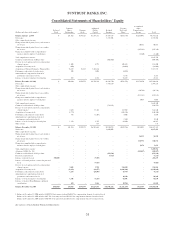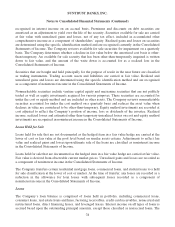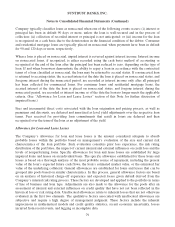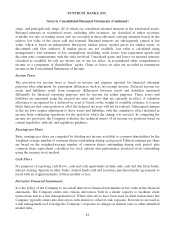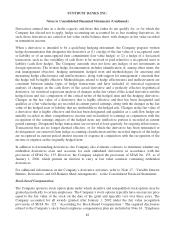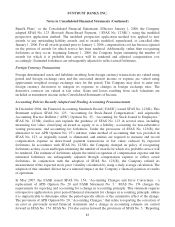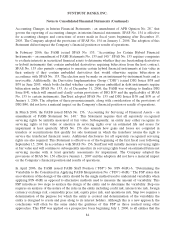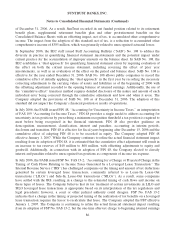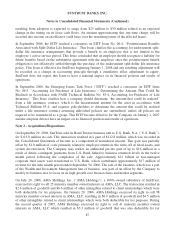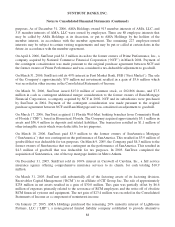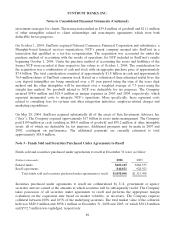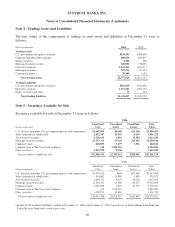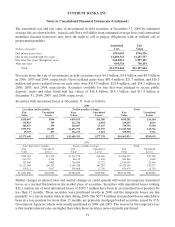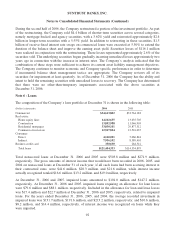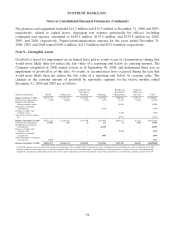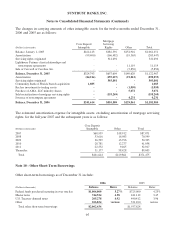SunTrust 2006 Annual Report Download - page 98
Download and view the complete annual report
Please find page 98 of the 2006 SunTrust annual report below. You can navigate through the pages in the report by either clicking on the pages listed below, or by using the keyword search tool below to find specific information within the annual report.SUNTRUST BANKS, INC.
Notes to Consolidated Financial Statements (Continued)
Company becomes involved with and to all entities previously required to be analyzed under FIN 46(R)
when a reconsideration event has occurred. The impact of adopting this FSP did not have an impact on
the Company’s financial position and results of operations.
In September 2006, the FASB issued SFAS No. 157, “Fair Value Measurements,” which clarifies how
companies should measure fair value when companies are required by US GAAP to use a fair value
measure for recognition or disclosure. SFAS No. 157 establishes a common definition of fair value, it
establishes a framework for measuring fair value in US GAAP, and it expands disclosures about fair
value measurements to eliminate differences in current practice that exist in measuring fair value under
the existing accounting standards. The definition of fair value in SFAS No. 157 retains the notion of
exchange price; however, it focuses on the price that would be received to sell the asset or paid to
transfer the liability (an exit price), rather than the price that would be paid to acquire the asset or
received to assume the liability (an entry price). Under SFAS No. 157, a fair value measure should
reflect all of the assumptions that market participants would use in pricing the asset or liability,
including assumptions about the risk inherent in a particular valuation technique, the effect of a
restriction on the sale or use of an asset, and the risk of nonperformance. To increase consistency and
comparability in fair value measures, SFAS No. 157 establishes a three-level fair value hierarchy to
prioritize the inputs used in valuation techniques between observable inputs that reflect quoted prices in
active markets, inputs other than quoted prices with observable market data, and unobservable data (a
company’s own data). SFAS No. 157 requires disclosures detailing (1) the extent to which companies
measure assets and liabilities at fair value, (2) the methods and assumptions used to measure fair value,
and (3) the effect of fair value measurements on earnings. In February 2007, the FASB issued SFAS
159, “The Fair Value Option for Financial Assets and Financial Liabilities.” This Statement permits
companies to elect on an instrument-by-instrument basis to fair value certain financial assets and
financial liabilities with changes in fair value recognized in earnings as they occur. The election to fair
value a financial asset or financial liability is generally irrevocable. These Statements are effective
January 1, 2008 for calendar year companies. Early adoption, effective January 1, 2007, is permitted as
long as companies adopt SFAS No. 157 concurrently with SFAS No. 159. SunTrust is currently
evaluating the impact of SFAS No. 159 and determining if early adoption of both SFAS No. 157 and
SFAS No. 159 is appropriate.
In September 2006, the FASB issued SFAS No. 158, “Employers’ Accounting for Defined Benefit
Pension and Other Postretirement Plans, an amendment of FASB Statements No. 87, 88, 106 and
132(R).” SFAS No. 158 requires companies to fully recognize an asset or liability for the overfunded or
underfunded status of their benefit plans in the statement of financial position. SFAS No. 158 also
requires that previously disclosed but unrecognized actuarial gains and losses, unrecognized prior
service costs and credits, and any transition assets or obligations remaining from the initial application
of SFAS No. 87 or SFAS No. 106 be recognized at adoption as a component of shareholders’ equity in
accumulated other comprehensive income, net of tax. Subsequent to adoption, these amounts will be
amortized into income and become a component of net benefit cost. Additionally, SFAS No. 158
eliminates a company’s ability to select a date to measure plan assets and obligations that is prior to its
year-end balance sheet date and requires all companies to measure plan assets and benefit obligations as
of their balance sheet dates effective for years ending after December 15, 2008. SunTrust’s
measurement date for plan assets and obligations is its year-end balance sheet date of December 31. The
provisions of SFAS No. 158 requiring recognition of a company’s funded status are to be applied
prospectively beginning December 31, 2006. The Company adopted the provisions of SFAS No. 158 as
85


